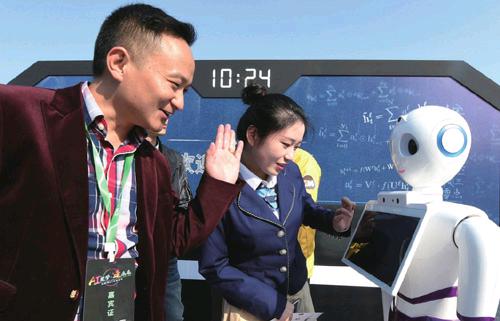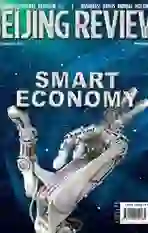GOING THE DISTANCE
2018-02-09ByMichaelZakkour
By+Michael+Zakkour
In the early years of the 2000s, a shoe factory in Wenzhou of east Chinas Zhejiang Province, founded by a local entrepreneur who secured clients in the West, would buy the cutting and shaping machines from Japan, and employ hundreds of employees to work in preproduction, production and postproduction, before exporting the goods to the U.S.
It was the combination of entrepreneurial leaders, ambitious and hardworking factory staff, and foreign made machinery that fueled Chinas rapid industrialization. This combination of talent and technology was the engine that propelled double digit growth in Chinas economy for more than 20 years.
In the historical context of development and modernization, China has sprinted from relative obscurity in a global economic context to the precipice of becoming the largest economy in the world, all in just 35 years. China has had to move quickly, after all it had a lot of catching up to do in a short amount of time, and in a world that was rushing into the future.
On the whole, this rapid growth has been a net positive for China, although it has come at a cost, in the form of pollution, strained urban resources, cultural change,unbalanced development and sacrifices for short-term gains.
The 12th (2011-15) and 13th (2016-20) five-year plans made it clear that China needs to reset, and re-imagine its economy for the 21st century.
In transition
Chinas accession to the World Trade Organization (WTO) in 2001 accelerated an already impressive run of growth. After accession to the WTO and prior to the Beijing 2008 Olympics was a time when the foreign brands that invested and sold in China were largely restricted to the top global luxury brands and mass-market consumer packaged goods companies.
However, something new was developing. The groundwork for the transition from an economy based on manufacturing to one built on innovation and domestic consumption was underway.
Reform and opening up entered a new phase. It became easier for foreign companies to invest in China, a second generation of bright and motivated entrepreneurs emerged, and the demand for goods and services started to spike as the country became richer. Thousands of new companies entered the Chinese market and Chinese companies started to go global for the first time.
Alibabas launch of Taobao in 2003 and Tmall in 2010 heralded the arrival of e-commerce as a major industry. By 2014 there were 1 billion mobile handsets registered. Massive growth in infrastructure made Chinese cities the envy of the developing and, in many instances, the developed worlds.endprint
China transformed itself from a low cost, low margin producer of goods, to the worlds largest consumer society, a world leading technology and innovation hub, an e-commerce powerhouse and the leading driver of worldwide growth generating 35.2 percent of the global total in 2017.
Before Chinas accession to the WTO, factories bought the machines that made the shoes. Afterward, China started making the machines and selling them to the “new Chinas” of the world. During this period however, it became apparent that rapid growth was not the only answer to Chinas continued development in a maturing economy and that adjustments had to be made.
The marathon
Between the sprint and transitional periods, the country has reached many key milestones. China has become the worlds second largest economy, one of the most important global technology and innovation hubs and the largest and most innovative e-commerce market. China also has the worlds fastest growing middle class, has assumed leadership in globalization, and has invested in a massive modern infrastructure build out.
Now, it is critical that on the domestic front, China avoids the “middle income trap” that has stalled the development of other fast rising economies in the past. Rapid growth is healthy in the earlier stages of development, but continuing to focus singularly on unsustainable growth will not be the long term solution for growth and development over the next 50 years. The time for sprinting is over; China must now prepare to win the marathon as well.
The rapid growth and transition phases were well executed but as was made clear the in the 12th and 13th five-year plans, the road ahead means Chinas economy must shift to “quality” rather than “quantity.”
New approaches
The recently concluded annual Central Economic Work Conference made “high quality development” the feature of Chinas new economic phase.
High quality development means steady progress in the direction the country has been moving for the last several years—technology and services driven, consumer focused, green, and healthcare oriented.
This requires a fundamental shift in psychology in terms of a greater tolerance and understanding at the central, provincial and municipal levels of government that the “new normal” is a slower, more sustainable and more value-added form of growth. This is not as easy as it sounds. There may be some difficulties and obstacles along the way toward high quality development, but the temptation to fall back on short term, fast growth attitudes, fixes and initia- tives must be avoided.endprint
The other fundamental shift is in creating new key performance indicators (KPIs). In the business world, a project or initiatives progress and success are judged and evaluated by setting up KPIs at the start and by adjusting them as the project progresses or the business grows. Usually when one set of KPIs is met, a new set is created for the next stage of growth.
Business, technology and political leaders in China must create new KPIs for high quality development. If the old KPIs for fast growth are used it will be difficult to gauge how the new economy is performing.
If you pound an orange with a hammer, you will quickly crush it while opening it to be eaten. But along the way, you are losing a lot of juice, much of the pulp and have quite a mess to clean up. Only if you are starving or being chased is this a wise method.
But, if you have cultivated your own orange grove, its better to slowly peel and cut the fruit, squeeze its juice and eat it, saving the rest for another day.
Whether in high value-added manufacturing, new services, finance, real estate, or technology, high quality growth comes from efficiently extracting the most out of every resource, keeping things clean and knowing where and when to invest, save and reinvest. It comes from the confidence that you are not in danger of losing everything if you slow down and focus on artistry over sheer force.
Chinas economic policy and performance on domestic and international fronts made significant progress in 2017. Consumer spending was up, exports were up, the Belt and Road Initiative made strides and per-capita GDP grew to over$8,000. This means that there is a firm foundation in place for the shift to high quality development.
With a focus on artificial intelligence, electric cars, establishing new trade routes, services and consumption, the blueprints for long term high quality development is in place. As always however, execution is what will prove the plan right.endprint
